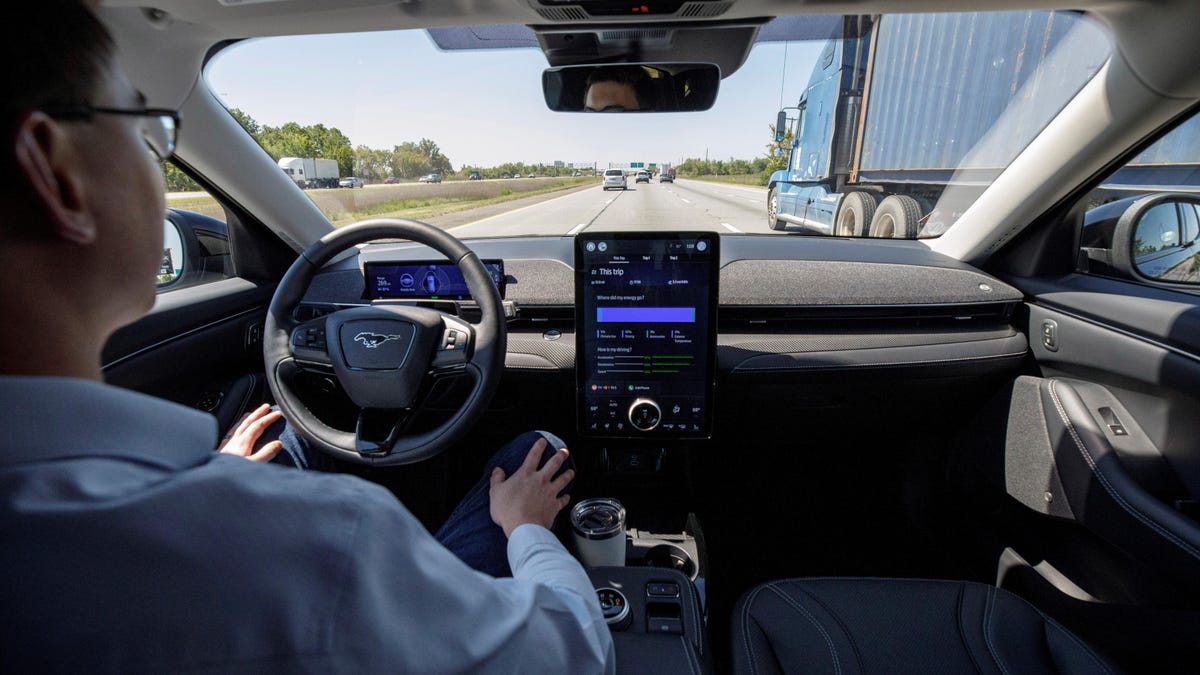Ford's BlueCruise Is Finally Getting 'Hands-Free' Lane Changing

Image: Ford
A sizable update is on the way for Ford’s BlueCruise Level 2 autonomous driving technology, and it’ll bring a long-awaited feature — hands-free lane changing. The automaker announced the new software today in a press release, stating that it’ll arrive first to 2023 Mustang Mach-E models in the fall, before filling out the rest of the BlueCruise-capable range.
In fairness, the system isn’t totally “hands-free” — you’ll first have to tap the turn signal stalk to request a lane change, before the car carries it out once it deems conditions safe enough. This feature is only one aspect of version 1.2, which also includes In-Lane Repositioning and Predictive Speed Assist. Here’s how they each work, courtesy of Ford’s press release:
Lane Change Assist can help drivers move through traffic on the freeway with more confidence while using BlueCruise. The system will perform a hands-free lane change when requested by the driver tapping the turn signal, and it can even suggest if a lane change would be beneficial when following slow-moving traffic.
Predictive Speed Assist automatically and smoothly adjusts the speed as drivers approach a sharp curve and will help signal the driver ahead of time when a speed change is about to occur, so they understand why the vehicle is slowing.
In-Lane Repositioning makes the hands-free highway driving experience feel more natural, keeping the vehicle in its lane while subtly shifting the vehicle’s position away from vehicles in adjacent lanes – especially helpful when next to bigger vehicles such as semis.
General Motors first enabled automatic lane changes in its Super Cruise semi-autonomous driving suite with 2021 models, so this is an important step in BlueCruise catching up to its most prominent — and most similarly named — rival. Especially considering the service didn’t enjoy the most auspicious of starts.
That said, GM still offers its software on considerably more cars. Right now, only the Mach-E, certain F-150 trims and the Lincoln Navigator can run BlueCruise. (Er- ActiveGlide in Lincoln speak. I wish I was making that up.) That’s compared to some six Chevrolet, GMC and Cadillac models and counting that are Super Cruise-ready.
G/O Media may get a commission
28% Off
Apple AirPods Pro Wireless Earbuds
Music+
These are the pinnacle of Apple AirPod design, and feature active noise cancelling, a transparency mode for when you need to hear what’s around you, spatial audio for accuracy, adaptive EQ, and are even sweat resistant.
Ford says that as of last month, some 75,000 drivers logged more than 16 million miles using BlueCruise and ActiveGlide. Ford also says it’s aiming for “human-like performance” for the system’s behavior, which is a point worth stressing.
The two lesser attention-grabbing features in release 1.2 — In-Lane Repositioning and Predictive Speed Assist — are really more about communicating the car’s actions to its occupants, and driving in a way that makes those occupants feel a little safer, even if it doesn’t actually make them safer. If we’re ever going to get to Level 3, those sorts of reassuring, quality-of-life improvements will need to be made to bridge the gap between self-driving and those moments of necessary human intervention.



